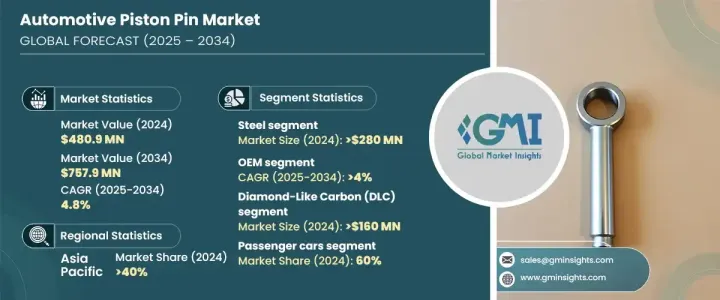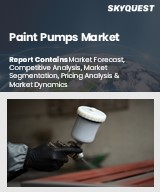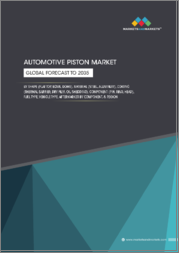
|
시장보고서
상품코드
1684726
자동차 피스톤 핀 시장 기회, 성장 촉진 요인, 산업 동향 분석, 예측(2025-2034년)Automotive Piston Pin Market Opportunity, Growth Drivers, Industry Trend Analysis, and Forecast 2025 - 2034 |
||||||
자동차 피스톤 핀 세계 시장은 2024년에는 4억 8,090만 달러로 평가되었고, 2025년부터 2034년까지의 CAGR은 4.8%를 나타낼 전망입니다.
자동차 제조업체는 보다 엄격한 배출가스 규정을 준수하면서 엔진 효율을 향상시켜야 한다는 압력에 항상 노출되어 있어 가볍고 견고한 피스톤 핀 수요가 계속 증가하고 있습니다. 연비 효율과 엔진 성능 향상에 대한 주목이 높아짐에 따라 제조업체는 고성능 피스톤 핀 생산을 위해 티타늄 합금과 같은 혁신적인 재료를 탐구하게 되었습니다. 첨단 재료로의 전환과 진화하는 환경 기준을 준수할 필요성은 앞으로 수년간 상당한 시장 확대를 촉진할 것으로 예상됩니다.

시장 성장의 큰 원동력이 되고 있는 것은 저연비에 공헌할 뿐만 아니라, 필요한 출력과 내구성을 유지하는 피스톤 핀에 대한 자동차 업계의 요구입니다. 자동차 제조업체는 성능과 환경에 대한 배려의 균형을 맞추는 과제에 직면하고 있으며, 피스톤 핀 기술은 이러한 목표를 달성하기 위해 더욱 진보되고 중요 해지고 있습니다. 제조업체는 전 세계 규정을 준수하면서 성능 사양을 충족하기 위해 재료 및 설계 개선에 주력하고 있습니다. 이와 같이 고도의 엔지니어링과 기술이 중시됨으로써, 보다 경량이고 강도가 높은 부품의 개발이 기대되고, 티타늄 합금은 그 견인역이 되고 있습니다.
| 시장 범위 | |
|---|---|
| 시작 연도 | 2024년 |
| 예측 연도 | 2025-2034년 |
| 시작 금액 | 4억 8,090만 달러 |
| 예측 금액 | 7억 5,790만 달러 |
| CAGR | 4.8% |
소재 부문에서는 스틸 카테고리가 2024년 시장을 독점하고 2억 8,000만 달러의 평가액을 차지했습니다. 스틸은 비용 효과, 인장 강도 및 탄성으로 인해 피스톤 핀 재료로 계속 선호되며 연소 엔진 내의 고온 및 고압 환경에 이상적입니다. 상용차와 승용차 모두에서 스틸 피스톤 핀이 널리 사용되는 것은 신뢰성과 저렴한 가격 때문입니다. 스틸의 성능과 경쟁가격은 상용차와 승용차 시장 수요에 부응하기 위해 제조업체에 중요한 이점을 제공합니다.
최종 용도의 경우 시장은 OEM과 애프터마켓 용도로 나뉩니다. OEM 분야는 2025년부터 2034년에 걸쳐 4%의 성장률이 전망되고 있습니다. 자동차 제조업체와 부품 제조업체 간의 협력 관계 강화는 특정 엔진 요구 사항에 맞는 전용 피스톤 핀의 개발을 촉진합니다. 엔진 효율성을 높이고 배출 가스를 줄이기 위한 피스톤 핀의 설계 혁신은 이러한 파트너십에 매우 중요합니다. 한편, 애프터마켓 분야는 강력한 성장을 이루고 있으며, 특히 자동차 보유대수가 증가하고 있는 개발도상지역에서는 교환부품의 요구가 높아지고 있습니다.
아시아태평양은 최대 시장 점유율을 차지하며 2024년에는 세계 시장의 40%를 차지합니다. 이 지역의 자동차 부문, 특히 상용차 부문의 성장은 최적의 엔진 성능과 연비 효율을 달성하는 데 중요한 역할을 하는 피스톤 핀과 같은 부품에 대한 수요를 촉진하고 있습니다. 알루미늄 및 티타늄 합금과 같은 경량 소재를 추구하는 움직임은 이 지역에서 기세를 늘리고 있으며 자동차 환경 실적을 줄이는 광범위한 산업 동향과 일치합니다. 이러한 첨단 재료의 비용 등의 과제에도 불구하고, 아시아태평양의 고성능 엔진에 대한 수요는 향후 수년간 자동차 피스톤 핀 시장의 확대를 크게 촉진할 것으로 예상됩니다.
목차
제1장 조사 방법과 조사 범위
- 조사 디자인
- 조사 접근
- 데이터 수집 방법
- 기본 추정과 계산
- 기준연도의 산출
- 시장추계의 주요 동향
- 예측 모델
- 1차 조사와 검증
- 1차 정보
- 데이터 마이닝 소스
- 시장 범위와 정의
제2장 주요 요약
제3장 업계 인사이트
- 생태계 분석
- 공급자의 상황
- 부품 제조업체
- 제조업체
- 유통업체
- 최종 사용자
- 이익률 분석
- 기술 혁신의 상황
- 특허 분석
- 규제 상황
- 비용 분석
- 재료 성능의 비교 분석
- 영향요인
- 성장 촉진요인
- 경량 엔진 부품에 대한 수요 증가
- 재료과학의 기술적 진보
- 신흥국의 자동차 생산 증가
- 하이브리드 엔진이나 수소 엔진으로의 시프트
- 업계의 잠재적 위험 및 과제
- 전기자동차 보급 대수 증가의 영향
- 첨단 재료의 고비용
- 성장 촉진요인
- 성장 가능성 분석
- Porter's Five Forces 분석
- PESTEL 분석
제4장 경쟁 구도
- 소개
- 기업 점유율 분석
- 경쟁 포지셔닝 매트릭스
- 전략 전망 매트릭스
제5장 시장 추정 및 예측 : 소재별, 2021년-2034년
- 주요 동향
- 철강
- 알루미늄 합금
- 티타늄 합금
제6장 시장 추정 및 예측 : 코팅별, 2021년-2034년
- 주요 동향
- 다이아몬드 라이크 카본(DLC)
- 물리 증착(PVD)
- 기타
제7장 시장 추정 및 예측 : 차량별, 2021년-2034년
- 주요 동향
- 승용차
- 해치백
- 세단
- SUV
- 상용차
- 소형 상용차(LCV)
- 대형 상용차(HCV)
제8장 시장 추정 및 예측 : 최종 용도별, 2021년-2034년
- 주요 동향
- OEM
- 애프터마켓
제9장 시장 추정 및 예측 : 지역별, 2021년-2034년
- 주요 동향
- 북미
- 미국
- 캐나다
- 유럽
- 영국
- 독일
- 프랑스
- 이탈리아
- 스페인
- 러시아
- 북유럽
- 아시아태평양
- 중국
- 인도
- 일본
- 호주
- 한국
- 동남아시아
- 라틴아메리카
- 브라질
- 멕시코
- 아르헨티나
- 중동 및 아프리카
- UAE
- 남아프리카
- 사우디아라비아
제10장 기업 프로파일
- Aisin Seiki
- Anand Automotive
- Arias Pistons
- Art Metal
- Bohai Piston
- Burgess Norton
- Comitans Capital
- Elgin Industries
- Federal-Mogul
- Hitachi Automotive Systems
- JE Pistons
- MAHLE
- Ming Shun Industrial
- Mubea
- Power Industries
- Rheinmetall Automotive
- Ross Racing Pistons
- Sarda Plywood Industries
- Shriram Pistons and Rings
- Tenneco
The Global Automotive Piston Pin Market was valued at USD 480.9 million in 2024 and is projected to experience significant growth, with an estimated CAGR of 4.8% from 2025 to 2034. As automotive manufacturers are under constant pressure to improve engine efficiency while complying with stricter emissions regulations, the demand for lighter and more robust piston pins continues to rise. The increasing focus on fuel efficiency and enhanced engine performance has led manufacturers to explore innovative materials, such as titanium alloys, for the production of high-performance piston pins. The shift towards advanced materials and the need for compliance with evolving environmental standards are anticipated to drive considerable market expansion in the coming years.

The market growth is largely driven by the automotive industry's need for piston pins that not only contribute to lower fuel consumption but also maintain the required power output and durability. As automakers face the challenge of balancing performance with environmental concerns, piston pin technology is becoming more advanced and crucial in meeting these objectives. Manufacturers are focusing on improving materials and designs to meet performance specifications while also adhering to global regulations. This emphasis on advanced engineering and technology is expected to lead to the development of lighter, stronger components, with titanium alloys increasingly gaining traction.
| Market Scope | |
|---|---|
| Start Year | 2024 |
| Forecast Year | 2025-2034 |
| Start Value | $480.9 Million |
| Forecast Value | $757.9 Million |
| CAGR | 4.8% |
In terms of material segments, the steel category dominated the market in 2024, accounting for a valuation of USD 280 million. Steel continues to be the preferred material for piston pins due to its cost-effectiveness, tensile strength, and elasticity, making it ideal for high-temperature and high-pressure environments within combustion engines. The widespread use of steel piston pins in both commercial and passenger vehicles is driven by their reliability and affordability. Steel's performance and competitive pricing provide manufacturers with a key advantage in meeting the demands of both the commercial vehicle and passenger car markets.
Regarding end-use segments, the market is split between Original Equipment Manufacturers (OEM) and aftermarket applications. The OEM segment is anticipated to grow at a rate of 4% between 2025 and 2034. Increased collaboration between automakers and component manufacturers is driving the development of specialized piston pins tailored to meet specific engine requirements. Innovations in piston pin design aimed at improving engine efficiency and reducing emissions are crucial to these partnerships. Meanwhile, the aftermarket segment is experiencing robust growth, especially in developing regions where vehicle ownership is rising, creating a greater need for replacement parts.
Asia Pacific holds the largest market share, accounting for 40% of the global market in 2024, with China leading the charge. The region's growing automotive sector, particularly in the commercial vehicle segment, is fueling the demand for components like piston pins, which play a vital role in achieving optimal engine performance and fuel efficiency. The push toward lighter materials such as aluminum and titanium alloys is gaining momentum in this region, aligning with the broader industry trend to reduce the environmental footprint of vehicles. Despite challenges, including the cost of these advanced materials, the demand for high-performance engines in Asia Pacific is expected to significantly drive the automotive piston pin market expansion in the years ahead.
Table of Contents
Chapter 1 Methodology & Scope
- 1.1 Research design
- 1.1.1 Research approach
- 1.1.2 Data collection methods
- 1.2 Base estimates & calculations
- 1.2.1 Base year calculation
- 1.2.2 Key trends for market estimation
- 1.3 Forecast model
- 1.4 Primary research and validation
- 1.4.1 Primary sources
- 1.4.2 Data mining sources
- 1.5 Market scope & definition
Chapter 2 Executive Summary
- 2.1 Industry 3600 synopsis, 2021 - 2034
Chapter 3 Industry Insights
- 3.1 Industry ecosystem analysis
- 3.2 Supplier landscape
- 3.2.1 Component providers
- 3.2.2 Manufacturers
- 3.2.3 Distributors
- 3.2.4 End users
- 3.3 Profit margin analysis
- 3.4 Technology & innovation landscape
- 3.5 Patent analysis
- 3.6 Regulatory landscape
- 3.7 Cost analysis
- 3.8 Comparative analysis of material performance
- 3.9 Impact forces
- 3.9.1 Growth drivers
- 3.9.1.1 Rising demand for lightweight engine components
- 3.9.1.2 Technological advancements in material science
- 3.9.1.3 Growing vehicle production in emerging economies
- 3.9.1.4 Shift toward hybrid and hydrogen engines
- 3.9.2 Industry pitfalls & challenges
- 3.9.2.1 Impact of rising electric vehicle adoption
- 3.9.2.2 High cost of advanced materials
- 3.9.1 Growth drivers
- 3.10 Growth potential analysis
- 3.11 Porter's analysis
- 3.12 PESTEL analysis
Chapter 4 Competitive Landscape, 2024
- 4.1 Introduction
- 4.2 Company market share analysis
- 4.3 Competitive positioning matrix
- 4.4 Strategic outlook matrix
Chapter 5 Market Estimates & Forecast, By Material, 2021 - 2034 ($Bn, Units)
- 5.1 Key trends
- 5.2 Steel
- 5.3 Aluminum alloy
- 5.4 Titanium alloy
Chapter 6 Market Estimates & Forecast, By Coating, 2021 - 2034 ($Bn, Units)
- 6.1 Key trends
- 6.2 Diamond-Like Carbon (DLC)
- 6.3 Physical Vapor Deposition (PVD)
- 6.4 Others
Chapter 7 Market Estimates & Forecast, By Vehicle, 2021 - 2034 ($Bn, Units)
- 7.1 Key trends
- 7.2 Passenger cars
- 7.2.1 Hatchback
- 7.2.2 Sedan
- 7.2.3 SUV
- 7.3 Commercial vehicles
- 7.3.1 Light Commercial Vehicles (LCV)
- 7.3.2 Heavy Commercial Vehicles (HCV)
Chapter 8 Market Estimates & Forecast, By End Use, 2021 - 2034 ($Bn, Units)
- 8.1 Key trends
- 8.2 OEM
- 8.3 Aftermarket
Chapter 9 Market Estimates & Forecast, By Region, 2021 - 2034 ($Bn, Units)
- 9.1 Key trends
- 9.2 North America
- 9.2.1 U.S.
- 9.2.2 Canada
- 9.3 Europe
- 9.3.1 UK
- 9.3.2 Germany
- 9.3.3 France
- 9.3.4 Italy
- 9.3.5 Spain
- 9.3.6 Russia
- 9.3.7 Nordics
- 9.4 Asia Pacific
- 9.4.1 China
- 9.4.2 India
- 9.4.3 Japan
- 9.4.4 Australia
- 9.4.5 South Korea
- 9.4.6 Southeast Asia
- 9.5 Latin America
- 9.5.1 Brazil
- 9.5.2 Mexico
- 9.5.3 Argentina
- 9.6 MEA
- 9.6.1 UAE
- 9.6.2 South Africa
- 9.6.3 Saudi Arabia
Chapter 10 Company Profiles
- 10.1 Aisin Seiki
- 10.2 Anand Automotive
- 10.3 Arias Pistons
- 10.4 Art Metal
- 10.5 Bohai Piston
- 10.6 Burgess Norton
- 10.7 Comitans Capital
- 10.8 Elgin Industries
- 10.9 Federal-Mogul
- 10.10 Hitachi Automotive Systems
- 10.11 JE Pistons
- 10.12 MAHLE
- 10.13 Ming Shun Industrial
- 10.14 Mubea
- 10.15 Power Industries
- 10.16 Rheinmetall Automotive
- 10.17 Ross Racing Pistons
- 10.18 Sarda Plywood Industries
- 10.19 Shriram Pistons and Rings
- 10.20 Tenneco



















